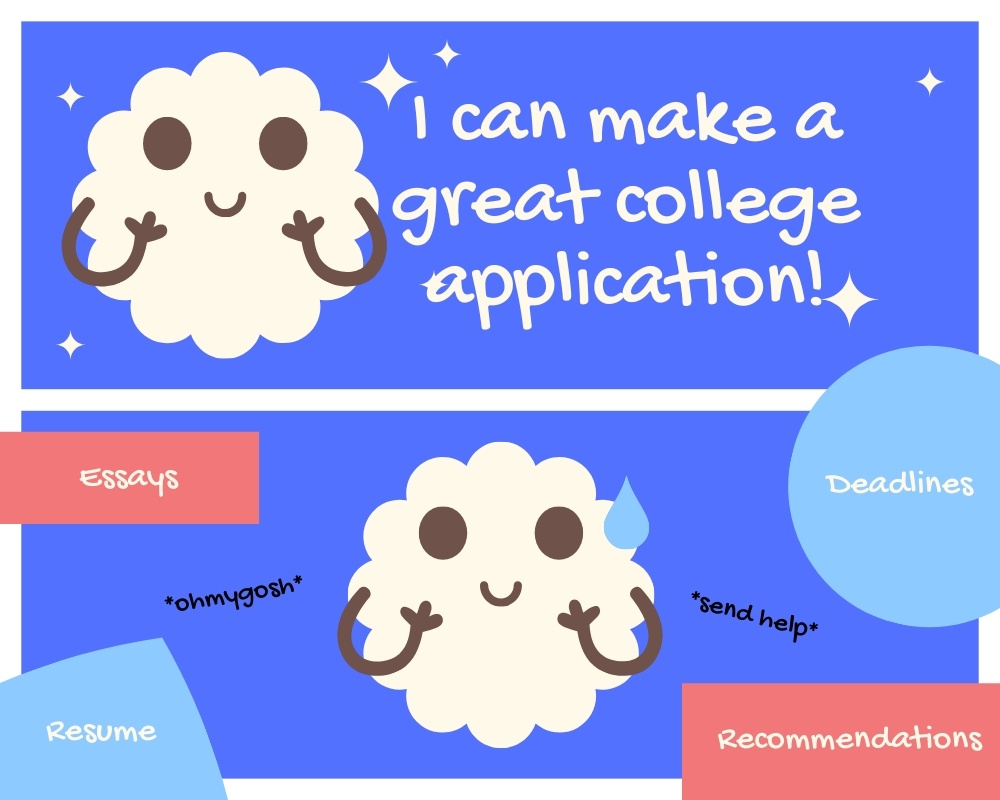When it comes to preparing for college applications, first you want to make sure that you get organized. It does not matter if you have impressive grades and test scores. Or if you are super involved with extracurricular activities and your teachers speak about you with high regard. All of this means nothing if you do not have a process or timeline for submitting your college applications.

If you are a junior, the summer months are a good time to get organized. However, you may be wondering where and how you should begin. This post will show you what to do to get organized. Key action items are:
- Developing a college list of where to apply.
- Making a spreadsheet of college requirements and materials to gather for each school.
- Building a system to organize application materials and correspondence in your email inbox.
- Creating a timeline of when to submit college applications, ideally well ahead of admission deadlines.
Develop a College List
When you are building a college list, your goal is to find colleges that fit you best. Don’t make the mistake of choosing the wrong college for you. If the school does not offer a major you are passionate about, or does not provide resources that will support your needs, then you risk dropping out or transferring to another college. Avoid this costly mistake and take the time to research colleges ahead of time. While it’s tempting to get a list of colleges from friends, don’t fall for it. A college that may work for them may not be best for you.
During the pandemic, a physical tour may not be possible, but find a virtual tour of campus to get a feel of what it’s like.
How do you choose colleges? Use a search engine like Niche or Cappex to research colleges. Look for schools that offer your desired degree and major. Then learn about them, as well as other similar colleges. Check out selectivity (how hard it is to get admitted) and the financial aid they provide to families (if this is of concern to you). Also, visit the college’s website to learn about campus life and its physical environment such as buildings, landscaping, and resources on campus. During the pandemic, a physical tour may not be possible, but find a virtual tour of campus to get a feel of what it’s like.
Make sure that you think about how close you want to be from your home, such as within a 2-hrs drive or 2-hrs plane ride. Also consider other things that matter to you such as diversity, proximity to urban centers, greek life, NCAA ranking, and the party scene for instance.
Once you discover 7 to 10 colleges that fit you, organize them into reach, target, and safety categories. A good list has:
- One or two reach colleges;
- Five or six target colleges; and
- Two safety colleges.
Track College Requirements
The fall that you apply to college will be like taking an additional class. You will have an instructor (your admissions counselor), who will be reading and grading your assignments. If you do a great job in putting together your application and you’re a good fit, chances are good that you will gain admissions. Materials you’ll need to put together include your general essay, supplemental essays, resume, transcript, brag sheet for stellar recommendation letters, and interviews.

Networking with Admissions Officers. Also in your plans, you’ll need to network with admissions officers ahead of time to make sure they know, like, and trust that you are a good fit for the school. Admissions officers are part of a committee and must spend time reading your application. When deciding who to admit, the admissions officer will present you to the committee for a vote.
My College Tracker. Completing college applications is a lot of work, and you’ll need a foolproof plan for keeping it all organized. I suggest that you use my college tracker, a spreadsheet that I developed that allows you to enter college information, deadlines, requirements, and track where you are in the process every step of the way. Many schools allow you to check applications using Naviance. As you complete application items, your counselor will be alerted by email.
Once you sign up for Common App or Coalition Application, transfer deadlines and requirements for each school into your college tracker spreadsheet. Also, devote a tab to storing passwords for your college site like the College Board, Common App, Coalition App, ACT, FAFSA, and so on. It can be hard to keep up with so many log-ins, so having them stored when you need them. My favorite tool to use is Google Sheets. In the next section, I will describe how to use Google Drive to organize your college application materials.
Store Application Materials in a Cloud Drive
Many students work on applications while at school or at home. If you want easy access to your application materials, wherever you go, you can use a cloud drive. My favorite, and one you are likely most familiar with, is Google Drive. Create a “College Application” folder as your master folder. In this folder, store your general college essay, resume, and brag sheet. Also store sub-folders for each college you’ll be applying to. In the sub-folders, you will store supplemental essays and other supporting documents. What’s great about this system is that you can link folders and documents to the College Tracker (saved as a Google Sheet) for easy retrieval, such as essays and your resume. As a bonus, you can also upload essays written in Google Docs directly into your Common App essay section. The same is true for other parts of the Common App that require an upload.
Manage and Monitor Your Inbox
You will need to manage communications between you and the college office. Email is the primary way that college officers will communicate with you. Make sure that you create and provide colleges with a professional email address, such as first.lastname@domain.com. Ideally, this account would be separate from the one that you use for your personal life. Make sure that you check the email account everyday to respond to time-sensitive emails. If there is a request that you do not understand, ask a parent or guidance counselor for help.
Organize Your Inbox. Keep every email you get from a college. To help you organize your inbox, I recommend that you label and sort emails by colleges so that you maintain a record of communication. You never know when you may need to refer back to an email.
Submit Applications on a Timeline
When you register for Common App or Coalition App, you may notice a series of deadlines. Many application deadlines will fall on the same day and will be determined by the cycle you want to be considered. The type of decision cycle is termed regular decision, early decision, early action, and rolling admissions for example. Regular decision deadlines usually fall between January 1 and February 1 and will have the largest pool of students applying. Early decision has an earlier deadline date, November 1 for the majority of colleges and is binding. Early action have the same November 1 deadline and is non-binding. Rolling admissions college applications are considered as they are received, meaning you can have a decision within weeks of submitting.
Facing many different deadlines or many college applications due on the same day, don’t wait until the last minute to make a submission plan. Get ahead of the curve by creating a timeline of submissions, either weekly or bi-weekly, starting two weeks before your first deadline. For example, if NYU, Boston University, and Ithaca College are due on November 1st, submit one college on October 15, a second on October 22, and the third on October 29. Try never to submit the application on the due date to avoid technical issues with the application that can result from the high volumes of other students trying to submit their applications.
Conclusion + Next Steps
In this post, I reviewed how you can get organized for college applications. Follow these steps to ensure that you have all ducks in a row before you get started and hit submit. Also, be sure to read 7 Steps to Creating a Stand Out Application.







